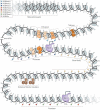Comparative studies of gene expression and the evolution of gene regulation
- PMID: 22705669
- PMCID: PMC4034676
- DOI: 10.1038/nrg3229
Comparative studies of gene expression and the evolution of gene regulation
Abstract
The hypothesis that differences in gene regulation have an important role in speciation and adaptation is more than 40 years old. With the advent of new sequencing technologies, we are able to characterize and study gene expression levels and associated regulatory mechanisms in a large number of individuals and species at an unprecedented resolution and scale. We have thus gained new insights into the evolutionary pressures that shape gene expression levels and have developed an appreciation for the relative importance of evolutionary changes in different regulatory genetic and epigenetic mechanisms. The current challenge is to link gene regulatory changes to adaptive evolution of complex phenotypes. Here we mainly focus on comparative studies in primates and how they are complemented by studies in model organisms.
Figures


References
-
- Carroll SB. Evo-devo and an expanding evolutionary synthesis: a genetic theory of morphological evolution. Cell. 2008;134:25–36. - PubMed
-
- Hoekstra HE, Coyne JA. The locus of evolution: evo devo and the genetics of adaptation. Evolution. 2007;61:995–1016. [References 1 and 2 summarize the on-going controversy regarding the relative importance of changes to structural proteins and changes in gene regulation to adaptation and speciation.] - PubMed
-
- Wray GA. The evolutionary significance of cis-regulatory mutations. Nature Reviews Genetics. 2007;8:206–16. - PubMed
Publication types
MeSH terms
Substances
Grants and funding
LinkOut - more resources
Full Text Sources

